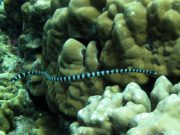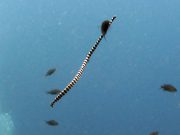Colubrine (Banded) Sea Krait
(Laticauda colubrina)
The yellow-lipped banded sea snake (Laticauda colubrina) is a species of highly venomous sea snake found in tropical Indo-Pacific oceanic waters, and at all of the dive sites around Koh Lanta.
The snake has 20 - 65 distinctive black stripes on a usually blue or blue-grey body and a usually (but not always) yellowish snout. These bands extend from the neck area to the tip of the paddle-like tail which is used for swimming. Adult males can reach 75 cm. Females are significantly larger than males, reaching 128 cm in length.
Female Laticauda colubrina @ Koh Bida
The banded sea snake spends much of its time underwater in order for it to hunt, but returns to land to digest, rest, slough skin, and reproduce. On land, the snakes drink fresh water.
These snakes primarily feed on varieties of eels, but also eat small fish. Adult males normally hunt in shallow water for small moray eels, and adult females normally hunt in deeper water for conger and garden eels They can hold their breath for long periods while they look for prey of eels and small fish, when they find some food they paralyze it through a bite and administer powerful venom. Despite often being much smaller than the eels they feed on, banded sea snakes swallow their prey whole, then return to land to digest their prey.
Banded Sea Krait @ Koh Haa
Banded Sea Krait @ Koh Bida
As with the sea turtles and other reptiles, the banded sea krait is oviparous, meaning it lays eggs that develop outside of the body. And just like the other reptiles, these snakes must come ashore to nest. A lesser known fact about the banded sea snake is that it exhibits 'philopatry' which means, just like with sea turtles, it will return to the same beach time and time again to digest, rest and lay eggs.
Mating occurs in the water whereby the male will 'chase' the female until he becomes entwined with her in order to mate. Females return to their 'home' beach to lay up to 10 eggs in a clutch, which they will deposit in a nest in a crevice or underneath ledges. The incubation period is 4 months, after which, the juvenile sea snakes will hatch and make their way to shallow water.
This species of sea snake is not aggressive, and only attacks when threatened. If they do bite, it is usually in self-defense when accidentally grabbed. Most sea snake bites occur when fishermen attempt to untangle the snakes from their fishing nets. An old wives tail is that their fangs are too small to bite a person but this is not true but with the fangs are only a few cm long it means that they would find it difficult to penetrate a thick wetsuit.
The banded sea snake is hunted by sea birds, sharks, some larger moray eels and some bony fish.



